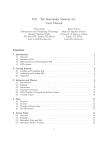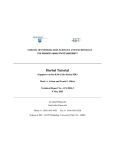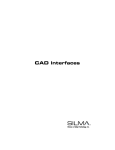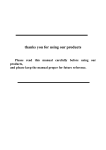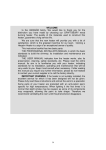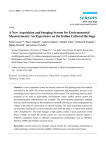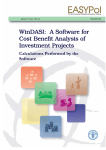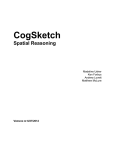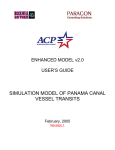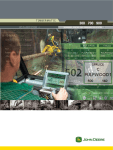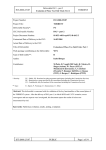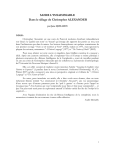Download Extending the Knowledge Machine
Transcript
Final thesis
Extending the Knowledge Machine
by
Markus Ingevall
LITH-IDA-EX–05/026–SE
2005-03-14
i
Final thesis
Extending the Knowledge Machine
by Markus Ingevall
LiTH-IDA-EX–05/026–SE
Supervisor: Professor Erik Sandewall
IDA
at Linköpings universitet
Examiner: Professor Erik Sandewall
Department of Computer and Information
Science
at Linköpings universitet
iii
Abstract
This master’s thesis deals with a frame-based knowledge representation
language and system called The Knowledge Machine (KM), developed by
Peter Clark and Bruce Porter at the University of Texas at Austin. The
purpose of the thesis is to show a number of ways of changing and extending
KM to handle larger classes of reasoning tasks associated with reasoning
about actions and change.
Keywords: Knowledge representation, reasoning about actions and change,
The Knowledge Machine, KM
v
Acknowledgements
I would like to thank my supervisor and all members of the Cognitive
Autonomous Systems Lab for their support during my work as well as Ola
Leifler who has provided the LATEX template used for producing this thesis.
vii
Contents
1 Introduction
1.1 Background . . . . . . . . . . . . . . . . . . . . . . . . . . .
1.2 Purpose and delimitations . . . . . . . . . . . . . . . . . . .
1.3 Reading guidelines . . . . . . . . . . . . . . . . . . . . . . .
2 Description of KM
2.1 Basics of KM . . . . . . . . .
2.2 Situation Mechanism . . . . .
2.3 Querying the knowledge base
2.4 Structure of the KM System .
2.5 Use of KM so far . . . . . . .
1
1
1
2
.
.
.
.
.
3
3
7
13
19
20
3 Limitations and extensions
3.1 Limitations of KM . . . . . . . . . . . . . . . . . . . . . . .
3.2 Extensions . . . . . . . . . . . . . . . . . . . . . . . . . . . .
21
21
24
4 Postdiction
4.1 Inspiration . . . . . . . . . . . . . . . . . . . . . . . . . . .
4.2 Implementation . . . . . . . . . . . . . . . . . . . . . . . . .
4.3 Usage . . . . . . . . . . . . . . . . . . . . . . . . . . . . . .
29
29
29
31
5 Checking effects and preconditions
5.1 Inspiration and implementation . . . . . . . . . . . . . . . .
5.2 Usage . . . . . . . . . . . . . . . . . . . . . . . . . . . . . .
33
33
34
.
.
.
.
.
.
.
.
.
.
.
.
.
.
.
.
.
.
.
.
.
.
.
.
.
.
.
.
.
.
.
.
.
.
.
.
.
.
.
.
.
.
.
.
.
.
.
.
.
.
.
.
.
.
.
.
.
.
.
.
.
.
.
.
.
.
.
.
.
.
.
.
.
.
.
.
.
.
.
.
CONTENTS
6 Changes to action
relations
6.1 Inspiration . .
6.2 Implementation
6.3 Usage . . . . .
definitions affecting instance-slot-value
. . . . . . . . . . . . . . . . . . . . . . . . .
. . . . . . . . . . . . . . . . . . . . . . . . .
. . . . . . . . . . . . . . . . . . . . . . . . .
7 Non-deterministic direct
7.1 Inspiration . . . . . .
7.2 Implementation . . . .
7.3 Usage . . . . . . . . .
37
37
38
38
effects
. . . . . . . . . . . . . . . . . . . . .
. . . . . . . . . . . . . . . . . . . . .
. . . . . . . . . . . . . . . . . . . . .
41
41
41
43
8 Concurrent actions
8.1 Inspiration . . . . . . . . . . . . . . . . . . . . . . . . . . .
8.2 Implementation . . . . . . . . . . . . . . . . . . . . . . . . .
8.3 Usage . . . . . . . . . . . . . . . . . . . . . . . . . . . . . .
45
45
45
47
9 New way of modelling actions
9.1 Inspiration . . . . . . . . . . . . . . . . . . . . . . . . . . .
9.2 Implementation . . . . . . . . . . . . . . . . . . . . . . . . .
9.3 Usage . . . . . . . . . . . . . . . . . . . . . . . . . . . . . .
51
51
52
55
10 Failed actions and sequences of actions
10.1 Inspiration . . . . . . . . . . . . . . . . . . . . . . . . . . .
10.2 Implementation . . . . . . . . . . . . . . . . . . . . . . . . .
10.3 Usage . . . . . . . . . . . . . . . . . . . . . . . . . . . . . .
59
59
59
60
11 Situation levels
11.1 Inspiration and implementation . . . . . . . . . . . . . . . .
11.2 Usage . . . . . . . . . . . . . . . . . . . . . . . . . . . . . .
69
69
71
12 Results and future work
73
A Dictionary
75
B New concepts in KM
79
1
Chapter 1
Introduction
1.1
Background
The inspiration for this master’s thesis has largely been two courses in
artificial intelligence given at Linköping Institute of Technology in 2003 and
2004. While the latter of the two specifically treated the area of interest
of this thesis, knowledge representation, the first course gave an overview
of artificial intelligence and the programming language Lisp. Knowledge of
Lisp has later been found to be indispensable for performing the work on
the thesis.
1.2
Purpose and delimitations
The purpose of this master’s thesis is to change and extend a knowledge representation system called The Knowledge Machine (KM) to handle larger
classes of reasoning tasks associated with reasoning about actions and
change.
The purpose is not to change the basic structure of the KM system
described in section 2.4 or to make a completely new implementation of
the KM language. Thus, the limitations of the system discussed in the
user manual [CPc] have not been considered. Instead, only changes and
1.3 Reading guidelines
extensions to the system related to the situation mechanism part of KM
have been implemented.
Additionally, a starting point for work on this thesis has been to only
take into consideration single world histories. Therefore, simulation of
multiple, possible futures as described in the situations manual [CPb] is
excluded.
1.3
Reading guidelines
The intended reader of this master’s thesis is a person interested either in
knowledge representation in general or in working with or making changes
to KM. Chapter 2 describes the original version of KM, including its use
so far. Limitations and extensions are then discussed in chapter 3. The
thesis continues by covering the implemented extensions in the subsequent
chapters and concludes by summarising the results and discussing future
work.
3
Chapter 2
Description of KM
2.1
Basics of KM
KM, The Knowledge Machine, is primarily the name of a frame-based
knowledge representation language developed by Peter Clark and Bruce
Porter at the University of Texas at Austin [CPc]. However, KM is also
used to denote the Lisp implementation of the language.
The basic unit of representation in KM is a frame, which may contain
slots. Each slot is associated with values, which may be atomic, or expressions referring to the same and/or other frames. The storage of frame-slotvalues relations in the KM system is denoted the knowledge base. There
are two kinds of frames, instances (individuals) and classes (types of individuals). In order to describe the properties of the members of a class,
expressions of the following form are used:
(every <class> has
(<slot1> (<expr11> <expr12> ...))
(<slot2> (<expr21> <expr22> ...))
...)
The slots (sloti ) may be regarded as binary relations, which hold between
the instances of the class and other instances. The expressions (exprij )
2.1 Basics of KM
evaluate to zero or more instances. Even though KM statements can usually
be translated into standard first-order logic notation, KM does not use such
a notation, as the above example clearly shows. By not using FOL notation,
the authors of KM have intended to make knowledge base construction
easier. However, as stated most KM expressions may be translated into
FOL notation. In the above case, the equivalent would be
∀x, y isa(x, class) ∧ y ∈ exprij (x) → sloti (x, y)
where exprij (x) is a function which returns the value of <exprij > for some
instance x of class and isa(x, c) is true if x is a member of class c.
The properties of a particular instance is described in a similar manner:
(<instance> has
(instance-of (<class1> ... <classn>))
(<slot1> (<expr11> <expr12> ...))
(<slot2> (<expr21> <expr22> ...))
...)
In this case, the slot relations hold between the instance and the values
acquired by evaluating the expressions. The values of the instance-of
slot are the names of the classes to which the instance belongs. The FOL
equivalent is
∀I, y y ∈ exprij (I) → sloti (I, y)
Here, exprij (I) returns the value of <exprij > for the instance I.
Classes can have properties of their own, which are not inherited by their
members. Most importantly, classes may have superclasses and subclasses,
representing supersets and subsets of members of the class. Class properties
are declared in the following way:
(<class> has
(superclasses (<superclass1> ... <superclassn>))
(<slot1> (<expr11> <expr12> ...))
(<slot2> (<expr21> <expr22> ...))
...)
5
The slots superclasses and subclasses are inverses of each other and
declaration is only needed one way. If, for instance, the class Car is declared
to be the subclass of Vehicle then Vehicle will be the superclass of Car.
Thus, a class for bananas could be described in the following way:
(Banana has
(superclasses (Fruit)))
(every Banana has
(colour (*Yellow))
(shape (*Bent)))
The FOL equivalents would be
superclasses(Banana, F ruit)
∀b isa(b, Banana) → colour(b, ∗Y ellow) ∧ shape(b, ∗Bent)
The * prefix in *Yellow and *Bent above is an example of the KM naming
conventions:
classes
slots
named instances
anonymous instances
variables
begin
begin
begin
begin
begin
with
with
with
with
with
an upper-case letter, eg. Banana
a lower-case letter, eg. colour
a * prefix, eg. *Yellow
a prefix, eg. Car13
a ? prefix, eg. ?x
As the naming conventions propose there are two kinds of instances in
KM, named and anonymous ones. The latter are usually created by the
system at run-time while evaluating expressions whose FOL equivalents
would include existential quantifiers (∃). In contrast to named instances,
the anonymous ones may be unified with other instances. When instances
are unified in KM they are asserted to be equal, i.e. they are asserted to
refer to the same instance. Obviously, in order for unification to work the
slot values of the instances being unified must not conflict, i.e. must be
equal or unifiable, and, as mentioned, named instances may not be unified
with each other as they are regarded to be unique.
To create a named instance of the Banana class defined earlier one might
write
2.1 Basics of KM
(*The-banana has
(instance-of (Banana)))
Slots are represented as instances of the built-in class Slot and are associated with a number of built-in slots which specify their properties. There
are six basic ones:
domain specifies the most general class(es) allowed for an instance using
the slot.
range specifies the most general class(es) allowed for the filler of the slot.
cardinality can take one of four values: 1-to-1, 1-to-N, N-to-1 or Nto-N. Their meaning is most easily explained by giving examples of
slots having the different kinds of cardinality, namely spouse, isfather-of, has-father and has-friends. A person can be married
to at most one other person. A father can have many children but
each child only has one father. A person can have many friends and
they can have many friends of their own. The default cardinality is
N-to-N. 1-to-1 and N-to-1 slots are denoted single-valued, whilst
the other two kinds are called multivalued.
inverse For instance, is-father-of and has-father are each other’s inverses. The default inverse of slot is slot-of.
subslots specifies more specific slots. For instance, sweaters might be a
subslot of clothes.
superslots is the inverse of subslots, i.e. more general slots.
Slots do not have to be explicitly declared. If no declaration is provided for
a certain slot its domain and range won’t be restricted and it will acquire
the default cardinality and inverse.
There are two main commands used for retrieving information from the
knowledge base, (showme <instance>) and (the <slot> of <instance>).
For the time being, it is sufficient to say that the showme command simply
displays what facts about the specified instance are currently stored in the
knowledge base whilst the other one computes the value of the specified
slot in the given instance. In what way this is done is further explained in
section 2.3. In the banana example given earlier, the command
7
(showme *The-banana)
would produce the answer
(*The-banana has
(instance-of (Banana)))
whilst
(the colour of *The-banana)
would return
(*Yellow)
since *The-banana is a banana and all bananas are yellow.
2.2
Situation Mechanism
Apart from its basic functionality, KM provides a situation mechanism
based on, but not identical to, Situation Calculus [CPb]. (An introduction
to Situation Calculus may be found in [RN03].) Its main concept is a situation, describing the state of the world at a certain moment. The ”normal”
knowledge base, which facts are entered into by default, is regarded as the
global situation, and its facts are common to all other situations, i.e. if
something holds in the global situation it holds in all other situations as
well. In KM terms, the global situation is the default supersituation. However, other situations may be supersituations as well, in which case what
is true in a supersituation also holds in all its underlying situations, its
subsituations. Facts may also be situation-specific, which means that they
hold in a certain situation but not necessarily in any other.
Situations are instances of the built-in class Situation and may be
ordered in time by being connected to each other. A situation can have
several next situations but only one previous. This reflects the notion that
two or more situations cannot be followed by a single one, whilst multiple,
possible futures are allowed. Next and previous situations are specified
using the built-in slots next-situation and prev-situation respectively.
2.2 Situation Mechanism
In order for some slots to be situation-dependent and others to be
situation-independent they need to be grouped into different categories.
This is done using the built-in slot fluent-status, which can have one
of three values, *Non-Fluent, *Fluent or *Inertial-Fluent. A *NonFluent slot carries the same value in all situations. A *Fluent slot has different values depending on the situation. Lastly, the value of an *InertialFluent slot may vary between situations but it persists from one situation
to the next if no change affecting the value takes place. Note that using
fluent status is KM’s way of treating the frame problem, i.e. how to efficiently represent the fact that, in general, most things don’t change but
stay the same from one situation to another.
The state of the world may change either due to explicit slot value
manipulation or as a result of actions. An action is an instance of the
built-in class Action and takes place between two situations. The latter
situation is created when the action is executed. The action is regarded
as being instantaneous and thus there is no situation corresponding to the
execution of the action. Actions are modelled using four lists represented by
slots, pcs-list (preconditions list), ncs-list (negated preconditions list),
add-list (add list) and del-list (delete list). pcs-list specifies what
must hold for the action to take place and ncs-list specifies what must
not hold. add-list contains propositions which become true as a result
of the action and del-list contains propositions which become false. In
FOL notation, this can be expressed in the following way:
∀s, s0 , p, a
∀s, s0 , p, a
∀s, s0 , p, a
∀s, s0 , p, a
holds-in(pcs-list(a, p), s) ∧ next-situation(s, s0 , a) → holds-in(p, s)
holds-in(ncs-list(a, p), s) ∧ next-situation(s, s0 , a) → holds-in(¬p, s)
holds-in(add-list(a, p), s) ∧ next-situation(s, s0 , a) → holds-in(p, s0 )
holds-in(del-list(a, p), s) ∧ next-situation(s, s0 , a) → holds-in(¬p, s0 )
holds-in(prop, s) denotes that prop holds in situation s and next-situation(s, s0 , a)
means that s0 is the next situation of s and that the situations are connected by action a. The above formulas state that the propositions of the
preconditions list are made to hold and the propositions of the negated
preconditions list are made not to hold. This corresponds to performing
an action using the KM command (do <action>). However, there is a
possibility, using the (try-do <action>) command instead, of performing
an action only if the propositions of the preconditions list hold and the
9
propositions of the negated preconditions list do not. In this case, the FOL
notation changes into
∀s, s0 , p1 , p2 , p3 , a next-situation(s, s0 , a) ∧ holds-in(add-list(a, p1 ), s)∧
holds-in(pcs-list(a, p2 ), s) ∧ holds-in(ncs-list(a, p3 ), s)∧
holds-in(p2 , s) ∧ holds-in(¬p3 , s)
→ holds-in(p1 , s0 )
∀s, s0 , p1 , p2 , p3 , a next-situation(s, s0 , a) ∧ holds-in(del-list(a, p1 ), s)∧
holds-in(pcs-list(a, p2 ), s) ∧ holds-in(ncs-list(a, p3 ), s)∧
holds-in(p2 , s) ∧ holds-in(¬p3 , s)
→ holds-in(¬p1 , s0 )
The do-and-next and try-do-and-next commands work the same way
as do and try-do respectively, except that the system stays in the new
situation after performing the action.
Actions may be regarded to have indirect as well as direct effects, of
which only the latter are stated in the action descriptions. The indirect
effects, or ramifications, are determined in KM by conditions, or rules,
associated with the affected slots. For instance, suppose there is an action
type Switch-on. Its direct effect might be that a certain switch changes
position, whilst as an indirect effect is that an electric current appears in
a certain wire. Indirect effects may give rise to other indirect effects as
well. For instance, the electric current might make a certain light go on.
As this example aims to show, it is difficult, if not impossible, to know
all the effects of an action if rules are used. One problem of using rules,
and thus allowing ramifications, is that actions might have contradictory
effects. Section 3.1 explains this further.
Below is an example with the aim of illustrating in what way the situation mechanism works. First, the following class and instance declarations
are entered:
(every Vehicle has
(has-wheels (*True)))
(Car has
(superclasses (Vehicle)))
2.2 Situation Mechanism
(*The-car has
(instance-of (Car)))
(*True has
(instance-of (Truth-value)))
(*Red has
(instance-of (Colour)))
(*Blue has
(instance-of (Colour)))
(*Yellow has
(instance-of (Colour)))
(*Green has
(instance-of (Colour)))
(*Purple has
(instance-of (Colour)))
(*Orange has
(instance-of (Colour)))
These are followed by the slot declarations:
(has-wheels has
(instance-of (Slot))
(fluent-status (*Non-Fluent)))
(speed has
(instance-of (Slot))
(fluent-status (*Fluent)))
(colours has
(instance-of (Slot))
(fluent-status (*Inertial-Fluent)))
11
(action-colours has
(instance-of (Slot))
(fluent-status (*Non-Fluent)))
(object has
(instance-of (Slot))
(fluent-status (*Non-Fluent)))
Next, three kinds of actions are specified:
(Remove-colour has
(superclasses (Action)))
(every Remove-colour has
(object ((a Car)))
(action-colours ((a Colour)))
(pcs-list ((:triple
(the object of Self)
colours
(the action-colours of Self))))
(del-list ((:triple
(the object of Self)
colours
(the action-colours of Self)))))
(Paint has
(superclasses (Action)))
(every Paint has
(object ((a Car)))
(action-colours ((a Colour)))
(add-list ((:triple
(the object of Self)
colours
(the action-colours of Self)))))
(Repaint has
(superclasses (Action)))
2.2 Situation Mechanism
(every Repaint has
(object ((a Car)))
(action-colours ((a Colour)))
(del-list ((:triple
(the object of Self)
colours
(the colours of (the object of Self)))))
(add-list ((:triple
(the object of Self)
colours
(the action-colours of Self)))))
In these action definitions the expressions (a Car) and (a Colour) are
used. An expression of this kind creates an anonymous instance of the
specified class, an instance, which may later be unified with another instance. Self, used in for instance (the object of Self), refers to the
object itself, in this case the action instance. The :triple expressions
are primarily used in action definitions but can be used separately as well.
(:triple <instance> <slot> <value>) represents the fact that the slot
of the instance carries the specified value. However, it is not an assertion
of the fact. To enter the fact into the knowledge base one would write
(assert (:triple <instance> <slot> <value>))
This is equivalent to
(<instance> has
(<slot> (<value>)))
To enter ”situation mode” the command (new-situation) is passed to KM.
This creates an anonymous instance of Situation and the system enters it,
i.e. it is regarded as the current situation. Asserting facts in the new
situation is done in the same way as in the global situation. One might for
instance write
(*The-car has
(colours (*Red *Blue))
(speed (70)))
13
To perform each of the actions of the example once one could write
(do-and-next (a Paint with
(object (*The-car))
(action-colours (*Green))))
(try-do-and-next (a Remove-colour with
(object (*The-car))
(action-colours (*Red))))
(do-and-next (a Repaint with
(object (*The-car))
(action-colours (*Yellow *Purple))))
The try-do-and-next command is used only in the case of (Removecolour). This is because the other action types lack preconditions. One
could use try-do-and-next to perform them as well but it would never
make any difference.
The first of the following three commands adds the value 90 to the
speed slot of *The-car. The second one creates a new situation without
performing any action, connects to the current one and enters it. The third
command adds the values *Blue and *Orange to the colours slot.
(*The-car has
(speed (90)))
(next-situation)
(*The-car has
(colours (*Blue *Orange)))
Section 2.3 uses the above example to explain in what way the system
computes slot values.
2.3
Querying the knowledge base
As mentioned in section 2.1, the command (the <slot> of <instance>)
returns the value of the slot in the specified instance [CPc]. In KM, the
2.3 Querying the knowledge base
function used for handling commands is called km0 [CPa]. It handles commands by matching them to a list containing command patterns and ”instructions” on how to handle commands of each kind. In the case of slot
value computation, the function km-slotvals-from-kb is called. It uses a
number of sources to compute the value:
• Prototypes
• Projection
• Subslots
• Local values (values from the current situation and its supersituations)
• Class inheritance
The function first adds in values from prototypes. However, this thesis does
not concern itself with prototypes and they will therefore not be explained
further. More information can be obtained in [CPc].
The local values are obtained by merging values from the current situation and its supersituations in the cases of *Fluent and *Inertial-Fluent
slots. If the slot is *Non-Fluent values are fetched only from the global
situation. The resulting values are unified together, if possible, and filtered
through any constraints found. If the slot is single-valued and the unification results in more than one value no consistent value can be found and
the system therefore produces an error message and deletes all values of
the slot in the current situation.
If the fluent status of the slot is *Inertial-Fluent and the query is
not passed from the global situation the system tries to project values from
previous situations, or rather makes a km0 request for the value of the
slot in the previous situation. All previous situations are thus investigated
by means of recursion. The values found are filtered through any local
constraints.
For each of the slot’s subslots, values are obtained by calling km0. The
subslot values, as well as projected values if the slot is multivalued, are then
unified with the local ones as far as possible. Subslot values, which cannot
be unified with local values are simply added if the slot is multivalued.
15
If it is single-valued and the unification produces more than one value no
consistent value can be found and, as in the case of the local values, the
system produces an error message and deletes all values of the slot in the
current situation.
At this point, the values found so far are saved in the knowledge base.
Then values are fetched from the instance’s classes and unified in. As
before, if the slot is single-valued the system produces an error message
and deletes all values of the slot in the current situation. The reason for
saving the values before getting the class values is that not doing so would
sometimes result in indefinite looping.
As mentioned before, the projected values are unified with the local and
subslot values only if the slot is multivalued. If it is single-valued projection
will result in a single value provided it is successful. The system tries to
unify that single value with what has already been found. If it does not
succeed the projected value is discarded. Lastly, for both kinds of slots the
produced value or values are saved in the knowledge base.
The slot-value computation may be expressed in a FOL-like manner.
In the basic case where the situation mechanism is not used, i.e. where all
slots may be regarded as *Non-Fluent it can be written in the following
way:
AN S = {x|slot(instance, x)}
= unif y-if -sv(OW N -V ALU ES, slot) ∪KM
unif y-if -sv(SU BSLOT -V ALU ES, slot) ∪KM
unif y-if -sv(IN HERIT ED-V ALU ES, slot)
where
OW N -V ALU ES = {x|own-value(instance, slot, x)}
SU BSLOT -V ALU ES = {x|subslot(slot, sub) ∧ sub(instance, x)}
IN HERIT ED-V ALU ES = {x|isa(instance, c) ∧ member-value(c, slot, x)}
own-value(instance, slot, value) is true if and only if the knowledge base
contains the relation instance-slot-value. subslot(slot, sub) means that
sub is a subslot of slot and member-value(class, slot, value) holds if and
only if the slot-value relation holds for all members of class. own-value,
2.3 Querying the knowledge base
subslot(slot, sub), and member-value are not defined in the KM manual
but are used here to make it to easier to explain the slot-value computation
procedure. The same holds for unif y-if -sv(set, slot), which attempts to
unify the members of the given set provided that the slot is single-valued.
AN S is used to denote the result of the query. ∪KM is a means of expressing
KM’s unification of sets. When sets are unified each set member is unified
with at most one member of another set. Members of the same set are
not unified. The resulting set will thus contain at least the same number
of members as the smallest of the unified sets. When two instances are
unified during set unification, just as in the case of separate unification of
instances, both of them must not be named instances and their slot values
must be equal or unifiable. However, for two instances to be unified during
set unification an additional condition must hold. The classes of one of the
instances must subsume or equal the classes of the other instance, i.e. the
instances must be of the same ”kind” or one of them has to be of a more
general kind than the other. If unification fails the KM system will report
an error and no result will be given.
In order for the situation mechanism to be included, some changes and
additions are required. The computation of slot values may now be expressed in the following way:
V ALU ES = {x|holds-in(slot(instance, x), sit)}
= unif y-if -sv(LOCAL-V ALU ES, slot) ∪KM
unif y-if -sv(SU BSLOT -V ALU ES, slot) ∪KM
unif y-if -sv(IN HERIT ED-V ALU ES, slot) ∪KM
{y|y ∈ P ROJECT ED-V ALU ES ∧ ¬single-valued(slot)}
where
LOCAL-V ALU ES = {x|[f luent-status(slot, ∗N on-F luent)∧
own-value(instance, slot, x)]∨
[¬f luent-status(slot, ∗N on-F luent)∧
own-or-supersituation-value(instance, slot, x, sit)]}
SU BSLOT -V ALU ES = {x|subslot(slot, sub) ∧ holds-in(sub(instance, x), sit)}
IN HERIT ED-V ALU ES = {x|isa(instance, c) ∧ member-value(c, slot, x)}
17
P ROJECT ED-V ALU ES =
unif y-if -sv({x|f luent-status(slot, ∗Inertial-F luent)∧
sit 6= ∗Global∧
prev-situation(sit, sit0 )∧
holds-in(slot(instance, x), sit0 )})
and
[¬single-valued(slot) → AN S = V ALU ES]∧
[single-valued(slot)∧
unif iable(V ALU ES, P ROJECT ED-V ALU ES)
→ AN S = V ALU ES ∪KM P ROJECT ED-V ALU ES]∧
[single-valued(slot)∧
¬unif iable(V ALU ES, P ROJECT ED-V ALU ES)
→ AN S = V ALU ES]
f luent-status(slot, f s) is true if and only if the fluent status of the slot is f s.
own-or-supersituation-value(instance, slot, value, sit) holds if and only if
the knowledge base contains the relation instance-slot-value for situation
sit or any of its supersituations. It should be noted that, when using the
situation mechanism, own-value defined earlier is only applicable to *NonFluent slots, which carry the same values in all situations. If the situation
mechanism is not used the fluent status does not affect the computation of
slot values.
As mentioned earlier, holds-in(prop, sit) is used to denote that prop
holds in the situation sit. For instance, if a query for the values of the slot
colours of the instance *The-car in the situation _Situation54 produces
the result (*Red *Blue) then holds-in(slot(*The-car,*Red),_Situation54)
and holds-in(slot(*The-car,*Blue),_Situation54) are true.
prev-situation(sit, sit0 ) is true if and only if sit0 is the previous situation
of sit and unif iable, which can take an arbitrary number of sets, is true
if and only if the sets can be unified. In the example from section 2.2, the
command (showme *The-car) produces the following result:
(*The-car has
(instance-of (Car))
(has-wheels (*True))
2.3 Querying the knowledge base
(object-of (_Paint2
_Remove-colour4
_Repaint6)))
(in-situation _Situation1
(*The-car has
(colours (*Red
*Blue))
(speed (70))))
(in-situation _Situation3
(*The-car has
(colours (*Red
*Blue
*Green))))
(in-situation _Situation5
(*The-car has
(colours (*Blue
*Green
(<> *Red)))))
(in-situation _Situation7
(*The-car has
(colours (*Yellow
*Purple
(<> *Blue)
(<> *Green)))
(speed (90))))
(in-situation _Situation8
(*The-car has
(colours (*Blue
*Orange))))
The command (the has-wheels of *The-car) will give the same result,
(*True), regardless of what situation the system is currently in since haswheels is a *Non-Fluent slot. However, that is not the case for colours
19
and speed whose values vary between situations. Since speed is a *Fluent slot the system won’t fetch values for it in any other situations. For
instance, in _Situation7 the command (the speed of *The-car) will
return the value 70, whilst it will give NIL, i.e. no value, in _Situation8.
In the example, _Paint2, an anonymous instance of Paint, is executed in _Situation1 producing _Situation3 and adding *Green to the
colours slot. It is followed by _Remove-colour4 leading to _Situation5
and adding (<> *Red) to the colours slot, i.e. prohibiting the instanceslot combination to take the value *Red in _Situation5. The last action to
be performed is _Repaint6, which removes the present colours *Blue and
*Green and adds the specified *Yellow and *Purple. In the last situation,
the colours *Blue and *Orange are added. Considering that colours is an
*Inertial-Fluent slot, one might wonder why it does not carry the values
*Yellow and *Purple from _Situation7 in _Situation8. The reason is
that the underlying principle in KM is never to compute anything unless
computation is explicitly requested. Thus, *Yellow and *Purple are not
automatically projected from _Situation7 to _Situation8. However, if
a request for the value is passed in _Situation8 by giving the command
(the colours of *The-car) it will result in the answer (*Yellow *Purple *Blue *Orange).
Slot value requests may be more complex than the ones presented
above. Suppose, for instance, that *Blue carries the slot nuance with the
value *Sky. Then, in _Situation8, the command (the nuance of (the
colours of *The-car)) will give the answer *Sky. Slot value commands
may be even more complex, which is described in [CPc] and [CPb].
2.4
Structure of the KM System
The KM system can be divided into three main parts: command processing,
computation, and knowledge base handling [CPa]. This division is not
explicitly described in the code or the manuals but appears apparent when
the code is examined. As mentioned, commands in KM are matched to a
list containing command patterns and instructions on how to handle the
different kinds of commands. The function responsible for performing the
matching is called km0.
2.5 Use of KM so far
In terms of amount of code, the computation part is the largest of the
three and the main area of interest for this thesis. As the name suggests, it
is where the ”reasoning” in KM is performed, for instance slot value computation. The last of the three parts is responsible for maintaining and
handling the KM knowledge base, i.e. what has been entered into the system. Apart from these three parts, there are some auxiliary functions used
for loading and saving knowledge base files and resetting the knowledge
base and two others used for displaying the version number and licence.
2.5
Use of KM so far
KM has mainly been used in three projects. The first of these was the
Botany Knowledge Base project, which was conducted from 1986 to 1994
and which generated the first early version of KM. According to the project
home page [bkb05], the goal was ”to create a laboratory for research on
AI tasks that require extensive knowledge, such as novel problem solving,
language understanding, and learning”.
Between 1999 and 2003, KM was used by the SRI team participating
in the Rapid Knowledge Formation (RKF) project. The aim of the project
was to enable experts of different fields untrained in AI to construct knowledge bases efficiently and accurately. The SRI team, made up of Boeing,
Information Sciences Institute (ISI) at University of Southern California,
Northwestern University, Stanford University, University of Massachusetts
at Amherst, University of Texas at Austin, University of West Florida,
Massachusetts Institute of Technology, and Pragati Systems, developed
the SHAKEN system. The group home page [sri05] is still maintained, in
contrast to the project home page. As part of the project, the possibility
of creating and executing rather elaborate plans was introduced. It is not
covered in the manuals but is explained in chapter 10. Currently, KM is
being used in the Halo project [hal05] whose goal is similar to that of the
RKF project.
Since these projects have not been mainly concerned with reasoning
about action and change they have not been a major source of inspiration
for this master’s thesis. In fact, nothing has been found indicating that
extensions similar to those of this thesis have been made to KM before.
21
Chapter 3
Limitations and
extensions
3.1
Limitations of KM
The KM manual [CPc] describes some known limitations not having to do
with the situation mechanism. As mentioned in section 1.2 these are not
within the area of interest of this thesis. Instead, this thesis concerns itself
with KM’s situation mechanism. The situations manual [CPb] contains a
discussion on known limitations of the situation mechanism, which include
• Chronological minimization
• Lack of projection back in time
• Disjunctive ramifications
• Modelling of continuous change
• The situation-action dichotomy
As explained in section 2.2, for *Inertial-Fluent slots KM will search for
values in all previous situations, the reason for this being that if an instanceslot-value relation holds in a certain situation then it may be presumed to
3.1 Limitations of KM
hold in later situations as well provided that it is not contradicted. Now
suppose that in a certain situation it is known that a cup is on a table,
that in a later situation it is no longer there and that no action has been
performed to remove the cup from the table. In this case, KM will draw
the conclusion that the cup is on the table in all situations up to the one
preceding the situation where the cup is known not to be on the table. This
is obviously too strong a conclusion to draw. In other words, KM assumes
changes to take place as late as possible, performing so-called chronological
minimization.
If an instance-slot-value relation is known to hold in a future situation
and no action is known to have been performed making the relation hold
then it could be assumed that the relation holds in earlier situations as
well. However, KM is not capable of drawing such conclusions.
As mentioned in section 2.2, if rules are used in KM, and thus ramifications are allowed, this may give rise to contradictory effects of actions.
For instance, suppose there is a person with dual citizenship of country A
and B who has to choose one citizenship at the age of 18. Thus, if she is a
citizen of country A at the age of 18 then she will no longer be a citizen of
country B and vice versa. In such a case, what is her citizenship at the age
of 18? In KM, the answer will depend on the modelling and in what order
queries are passed. The scenario could be set up in the following way:
(age has
(instance-of (Slot))
(fluent-status (*Fluent))
(cardinality (N-to-1)))
(citizen-of-A has
(instance-of (Slot))
(fluent-status (*Inertial-Fluent))
(cardinality (N-to-1)))
(citizen-of-B has
(instance-of (Slot))
(fluent-status (*Inertial-Fluent))
(cardinality (N-to-1)))
23
(*The-person has
(citizen-of-A ((if ( ((the age of Self) >
and ((the citizen-of-B
then *No
else *Yes)))
(citizen-of-B ((if ( ((the age of Self) >
and ((the citizen-of-A
then *No
else *Yes))))
17)
of Self) = *Yes))
17)
of Self) = *Yes))
(new-situation)
(*The-person has
(age (17))
(citizen-of-A (*Yes))
(citizen-of-B (*Yes)))
(next-situation)
(*The-person has (age (18)))
Here, when queries are passed for citizen-of-A and citizen-of-B KM
will return *No as a response to the first query and *Yes as a response to
the second one. It should be noted that the direct effects of actions are
explicitly not allowed to be disjunctive. It is thus not possible to model
non-deterministic actions.
Another limitation of KM is that it does not offer any means of modelling continuous change other than by representing it in the form of several
discrete actions. Such a representation is not sufficient in all cases. Furthermore, KM makes a clear distinction between actions and situations,
not allowing modelling of things happening during the execution of an action, i.e. actions are presumed to be instantaneous. In addition to this,
execution of actions is limited to one at a time. Thus, concurrent actions
are not allowed. Additionally, there is no efficient way of modelling delayed
effects of actions.
In KM, even though an action’s definition may be changed after it has
been performed the changes won’t affect any instance-slot-value relations.
3.2 Extensions
If the action is executed again, using for instance the (do <action>) command, a new situation is created in which the effects are asserted, leaving
the old next situation unaffected.
Since instance-slot-value relations may be added or removed at any
time in the global or any other situation instance-slot-value relations may
sometimes contradict the effects and preconditions of the actions which
have been performed. However, KM is unable to detect such contradictions
and will take no notice of the effects and preconditions once the actions have
been performed.
3.2
Extensions
A number of possible ways of extending KM have been considered, partly
inspired by the limitations discussed in section 3.1:
• Projection back in time (postdiction)
• Check of effects and preconditions
• Changes to action definitions affecting instance-slot-value relations
• Non-deterministic direct effects
• Concurrent actions
• New way of modelling actions
• Failed actions and sequences of actions
• Situation levels
• Continuous change
Each of these is discussed briefly below and those implemented are further
described in the following chapters.
As described in section 2.2, KM allows a situation to be followed by
more than one other situation, thus providing the possibility of modelling
multiple, possible futures. However, such modelling is outside the area of
interest of this master’s thesis and thus, each situation is allowed to have at
25
most one next situation. Note that this does not affect the FOL formulas
associated with performing actions presented in section 2.2.
Projection back in time, also known as postdiction, has been implemented and is covered in chapter 4. In short, values are fetched from a
future situation if the preceding action does not affect them. If projected
and postdicted values cannot be combined with values from other sources
the values from the other sources are used and an error message is passed.
As described in section 3.1, contradictions may appear between instanceslot-value relations on the one hand and the effects and preconditions of
actions on the other. In the new version resulting from this thesis this is
handled in connection to querying by passing error messages when contradictions are discovered.
The possibility of letting changes to action definitions affect instanceslot-value relations has been implemented by changing the way actions
are performed. Simply put, if the situation in which a certain action is
performed already has a next situation no new situation is created. Instead,
the effects of the action are made to hold in the existing next situation.
The situations manual [CPb] stating that the original version of KM
explicitly prohibits the direct effects of actions to be disjoint, i.e. nondeterministic, has inspired looking into the question of introducing nondeterministic direct effects. As mentioned in section 3.1, non-determinism
may occur in the original version of KM due to disjunctive ramifications.
Handling this kind of non-determinism would require extensive computations considerably slowing down the system. Therefore, no effort has been
put into it. However, it is imaginable that there may be a need to represent
actions whose effects are partly but not completely known. Suppose for instance that it is known that a six-sided die is tossed but that the result of
the toss is unknown. Even though one cannot say what number turned up
it is known that it was either one, two, three, four, five, or six. Thus, one
of these values should be present in the next situation. If it is not an error
message is passed.
The extensions related to concurrent actions and a new way of modelling
actions have both been inspired by [Gus01]. In the original version of KM,
two situations may be joined by only one action. Concurrency is thus not
a possibility. It has however been introduced in the version resulting from
this thesis and is covered in chapter 8. Apart from basic changes to the
3.2 Extensions
system, allowing more than action to join two situations requires handling
conflicts between actions. However, actions are performed using the same
commands as before.
Concurrency in the form presented above somewhat extends modelling
flexibility. However, actions being performed during several situations and
actions having delayed effects are still not easily represented. Chapter 9
shows in what way KM has been modified to facilitate this kind of modelling.
[San97a], and to some degree [San97b], discuss success and failure of
actions as well as sequences of actions. It has motivated investigating how
to model this in KM, the conclusion being that no major changes are needed
and that, in fact, KM allows for more kinds of sequences than the ones
presented in [San97a]. What has been found out is covered in chapter 10.
The last of the implemented extensions was inspired by a discussion on
whether there would be a point in organising situations on different levels
of detail, in other words letting the values of instance-slot combinations
sometimes vary within situations. What has been concluded is covered in
chapter 11.
The last of the presented extensions, continuous change, has not been
implemented. After looking into the issue it was concluded that trying to
implement continuous change would not be worth the effort when put in
relation to other possible extensions.
Table 3.1 aims to show what aspects of the system have been affected by
the implemented extensions: querying (”Out”), knowledge base construction (”In”), or both.
27
Extensions
Postdiction
Check of effects and preconditions
Changes to action definitions affecting
instance-slot-value relations
Non-deterministic direct effects
Concurrent actions
New way of modelling actions
Failed actions and sequences of actions
Situation levels
Table 3.1: Extensions
”Out”
X
X
X
X
X
X
”In”
X
X
X
X
X
X
3.2 Extensions
29
Chapter 4
Postdiction
4.1
Inspiration
The idea of introducing postdiction is based mainly on the KM situations
manual [CPb], and more specifically on the limitations described in it,
which are discussed in section 3.1.
4.2
Implementation
Recall that when calculating slot values the basic system takes into account
values from earlier situations, but only if those values are compatible with
the values already found for the slot in the case of single-valued slots. The
approach taken here is similar with the addition that postdicted values
are also taken into consideration. As mentioned in section 3.2, values are
fetched from a future situation (”postdicted”) if the preceding action does
not affect them.
When introducing postdiction, if care had not been taken, projection
and postdiction could have interacted in such a way that situations would
have been visited more than once. To avoid this the system has to keep
track of which situations have already been checked in the current query.
Using the notation of section 2.3, the new way of computing slot values can
4.2 Implementation
be expressed in the following way:
V ALU ES = {x|holds-in2(slot(instance, x), sit, vis-sit)}
= unif y-if -sv(LOCAL-V ALU ES, slot) ∪KM
unif y-if -sv(SU BSLOT -V ALU ES, slot) ∪KM
unif y-if -sv(IN HERIT ED-V ALU ES, slot) ∪KM
{y|y ∈ P ROJECT ED-V ALU ES ∧ ¬single-valued(slot)} ∪KM
{z|z ∈ P OST DICT ED-V ALU ES ∧ ¬single-valued(slot)}
where
P ROJECT ED-V ALU ES =
unif y-if -sv({x|f luent-status(slot, ∗Inertial-F luent)∧
sit 6= ∗Global∧
prev-situation(sit, sit0 )∧
sit0 6∈ vis-sit∧
holds-in2(slot(instance, x), sit0 , vis-sit ∪ sit0 )})
P OST DICT ED-V ALU ES =
unif y-if -sv({x|f luent-status(slot, ∗Inertial-F luent)∧
sit 6= ∗Global∧
next-situation(sit, sit0 )∧
sit0 6∈ vis-sit∧
¬af f ected-by-action(instance, slot, sit)∧
holds-in2(slot(instance, x), sit0 , vis-sit ∪ sit0 )})
and
[¬single-valued(slot) → AN S = V ALU ES]∧
[single-valued(slot)∧
unif iable(V ALU ES, P ROJECT ED-V ALU ES, P OST DICT ED-V ALU ES)
→ AN S = V ALU ES ∪KM
P ROJECT ED-V ALU ES ∪KM
P OST DICT ED-V ALU ES]∧
[single-valued(slot)∧
¬unif iable(V ALU ES, P ROJECT ED-V ALU ES,
P OST DICT ED-V ALU ES)
→ AN S = V ALU ES]
31
LOCAL-V ALU ES, SU BSLOT -V ALU ES, and IN HERIT ED-V ALU ES
are the same as before. holds-in2(prop, sit, vis-sit) is a variant of holdsin, which takes into account what situations have already been visited. As
expected, next-situation(sit, sit0 ) is true if and only if sit0 is the next situation of sit. af f ected-by-action(instance, slot, sit) holds if and only if the
instance-slot combination is affected by the action performed in situation
sit. Note that if the slot is single-valued and the projected and postdicted
values cannot be unified with V ALU ES neither projected nor postdicted
values are used.
4.3
Usage
The example from section 2.2, with the addition of the *Inertial-Fluent
slot passengers, may be used to show in what way postdiction works.
Suppose that situation mode is entered and that the next-situation command is passed before performing a Paint action:
(new-situation)
(next-situation)
(do-and-next (a Paint with
(object (*The-car))
(action-colours (*Green))))
At this point, the car is asserted to carry two passengers:
(*The-car has
(passengers (*Lisa *Kalle)))
There are now three situations, named _Situation1, _Situation2 and
_Situation4 due to the way KM numbers anonymous instances. In _Situation4, the car is green and carries the passengers Lisa and Kalle. If a
query is passed for the passengers slot in _Situation1 the system postdicts the values *Lisa and *Kalle from _Situation4 through _Situation2 to _Situation1. On the other hand, no value is returned for the
colours slot since its value in _Situation4 is a result of the Paint action.
This reflects the assumption that what is true in a certain situation is true
in earlier situations as well provided that no action has made it true.
4.3 Usage
33
Chapter 5
Checking effects and
preconditions
5.1
Inspiration and implementation
As mentioned in section 3.1, the original version of KM is not able to detect
contradictions between instance-slot-value relations on the one hand and
the effects and preconditions of actions on the other. Contradictions related
to effects and preconditions arise for four different reasons:
• The add list contains instance-slot-value relations, which do not hold
in the next situation.
• The delete list contains instance-slot-value relations, which do hold
in the next situation.
• The preconditions list contains instance-slot-value relations, which do
not hold in the preceding situation.
• The negated preconditions list contains instance-slot-value relations,
which do hold in the preceding situation.
As described in section 2.3, slot value computations in KM are only performed if requested, i.e. when queries are passed either directly from the
5.2 Usage
user or as part of other computations. Therefore, checking of effects and
preconditions should be done in connection to querying.
In the version of KM resulting from the work done on this thesis, contradictions found during checking of effects and preconditions are handled
simply by passing error messages. The values of the instance-slot combination passed to the query are not affected. One could imagine changing the
values in accordance with the actions in order to eliminate the contradictions, either automatically or after asking the user. However, suppose that
the slot values found by a query are first checked against the effects of the
preceding action. Contradictions are found but are eliminated by changing
the slot values. Next, the system checks the preconditions of the next action and discovers contradictions. In such a case the latter contradictions
could very well have been caused by the changes done to the slot values.
They could be removed in the same way as the first contradictions but then
they could reappear since there actually might be no set of slot values consistent with both the effects of the preceding action and the preconditions
of the next action. Therefore, the choice has been made to only let the
system produce error messages when contradictions are detected and leave
it to the user to change the knowledge base manually. It should also be
pointed out that when contradictions arise it is not obvious whether slot
values, actions, or both should be changed.
It cannot be expected always to be desirable or necessary for the system to search for contradictions related to the effects and preconditions of
actions. One might want to be able to switch off the checking mechanism.
This is done by passing the command (dont-check-effects-and-pcs).
The checking mechanism can be switched on again using the command
(check-effects-and-pcs). *Non-Fluent slots are always excluded from
checking of effects and preconditions since their values are global, i.e. do
not vary between situations.
5.2
Usage
Recall the example from section 2.2. It is used here to demonstrate the
checking of effects and preconditions. After entering situation mode a
Paint action is performed which adds *Green to the colours slot of *The-
35
car:
(do-and-next (a Paint with
(object (*The-car))
(action-colours (*Green))))
The next step is to execute a Repaint action:
(do-and-next (a Repaint with
(object (*The-car))
(action-colours (*Yellow *Purple))))
However, Repaint now has a slightly different definition containing preconditions and negated preconditions lists:
(every Repaint has
(object ((a Car)))
(action-colours ((a Colour)))
(pcs-list ((:triple
(the object of Self)
speed
0)))
(ncs-list ((:triple
(the object of Self)
driving
*True)))
(del-list ((:triple
(the object of Self)
colours
(the colours of (the object of Self)))))
(add-list ((:triple
(the object of Self)
colours
(the action-colours of Self)))))
The new lists may be regarded as representing the need for the car not
to move while being repainted. There are now three situations and two
actions:
5.2 Usage
_Situation1
_Paint2
_Situation3
_Repaint4
_Situation5
Now, the colours slot of *The-car is changed to only include *Yellow:
(*The-car now-has (colours (*Yellow)))
The now-has command has not been explained earlier. It sets the value
associated with a certain instance-slot combination and removes all old
values as opposed to the has command, which merely adds values. A query
for the colours slot of *The-car in _Situation5 will now produce an error
message stating that the values (in this case ”value”) found for the instanceslot combination are incompatible with the effects of the preceding action
_Repaint4. The error message is triggered by the absence of *Purple.
Apart from adding the values *Yellow and *Purple to the colours slot
_Repaint4 removes the value *Green present in _Situation3. Therefore,
a query for the colours of *The-car in _Situation5 will produce an error
message if *Green has been added to the colours slot.
Since the Repaint action is performed using the do-and-next command the contents of the preconditions list are asserted to be true, i.e. the
instance-slot-value relation (*The-car speed 0) is asserted to hold. Correspondingly, (*The-car driving *True) is asserted not to hold. Setting
the value of driving to *True or the value of speed to something other
than zero and then passing queries for the slots will result in error messages
stating that the found values are incompatible with the preconditions of
the next action _Repaint4.
37
Chapter 6
Changes to action
definitions affecting
instance-slot-value
relations
6.1
Inspiration
During construction of a knowledge base one might need to make changes
to action definitions after the actions have been performed. The reason
may be either that some parts of the definitions have been found to be
wrong or irrelevant or that something that should be included has been
overlooked. There might even be a need to introduce new actions joining
situations, which were earlier regarded as having no action between them.
In order to satisfy this need, changes to action definitions must be allowed
to affect instance-slot-value relations.
6.2 Implementation
6.2
Implementation
As described in section 2.2, when an action is performed in the original
version of KM a new situation, connected to the current situation, is always
created, regardless of whether the action has already been performed or
not. There is no possibility of ”reperforming” actions. If one wanted to
introduce such a possibility while retaining modelling of multiple, possible
futures there would be a need to create a new set of redo commands (or the
like) to separate performing actions from ”reperforming” them. In the latter
case no new next situations would be created. However, since a starting
point for all extensions to KM described in this thesis is to allow each
situation to have at most one next situation there is no need to introduce
redo commands. Instead, the existing do commands are used in the new
version but work in a somewhat different way.
In the original version, an action is always executed in the current situation. In the new version, however, if the action to be performed carries
a situation in its before-situation slot it is performed in that situation
instead. In other words, actions are performed in their specified before situations if such exist and only if that is not the case in the current situation.
In FOL notation, the ”old” way of determining the next situation of an
action could be formulated
perf ormed-in(a, s) → ∃s0 next-situation(s, s0 , a)
whilst the new way corresponds to
perf ormed-in(a, s)
→ [(∃s00 bef ore-situation(a, s00 ) → next-situation(s00 , s0 , a))∧
(¬∃s00 bef ore-situation(a, s00 ) → ∃s0 next-situation(s, s0 , a))]
6.3
Usage
The example given in section 2.2 is used here to illustrate how to make
use of the extension to KM presented in this chapter. After entering into
situation mode an instance of the action class Paint is created:
(a Paint with
39
(object (*The-car))
(action-colours (*Green)))
It may be called _Paint2, represents the belief that a certain car is painted
green and is performed by passing the command
(do-and-next _Paint2)
Now suppose that at some later point in time it is found out (or rather
believed) that the car was actually painted red. To reflect this, _Paint2 is
changed in the following way:
(_Paint2 now-has (action-colours (*Red)))
_Paint2 may now be ”reperformed” by using either the do or the do-andnext command. If do is chosen the action is performed and the system
then returns to whatever was the current situation whilst in the case of
do-and-next it ends up in the situation following the action. As before,
if try-do or try-do-and-next are used the action is performed only if its
preconditions are satisfied.
In order for changes to action definitions to work properly the fluent
status of all slots used must be *Non-Fluent. Otherwise, changes made
in situations other than the one where the action is performed will have
no effect since, in that case, the changes are made locally in the current
situation and not globally as is necessary. For instance, in the example
presented here object and action-colours should be *Non-Fluent.
Notice that, in the above example, the add and delete lists are not
directly changed, only the object and action-colours slots. There is
no point in making direct changes to the add, delete, preconditions or
negated preconditions lists of an action instance because their old values
are removed when the action is performed and new values are computed
from the action class definition. There are two reasons for this. Firstly,
if old values were not removed reperforming changed actions would not
produce the desired result. Secondly, the chosen method ensures that all
instances of a certain class, for example Paint, follow the class definitions
and do not behave in an unexpected way. Additionally, if the definition
of a certain action class is changed then when any instance of the class is
performed the new definition is used even if the instance was created before
the change.
6.3 Usage
41
Chapter 7
Non-deterministic direct
effects
7.1
Inspiration
The situations manual [CPb] describes that the original version of KM
explicitly prohibits the direct effects of actions to be disjoint, i.e. nondeterministic. This has been the main inspiration for looking into the
question of introducing non-deterministic direct effects in KM.
7.2
Implementation
Non-deterministic direct effects are represented using the new built-in class
Set-of-effects. An instance of this class should contain an add list and
a delete list specifying a set of effects. A number of sets of effects are then
contained in the sets-of-effects slot of an action. sets-of-effects
is a new built-in slot. If an action is associated with a sets-of-effects
slot carrying a value it is presumed to carry all its effects in that slot and
regular add and delete lists are disregarded.
When the action is performed only what is common to all sets of effects
7.2 Implementation
is asserted in the next situation. When the effects of an action containing
non-deterministic direct effects are checked for contradictions to the values
of an instance-slot combination found during querying in the next situation
an error message is given only if the values from the query are inconsistent
with all the sets of effects of the action. If one or more of the sets of
effects support the values found by the query the values are regarded to be
consistent with the action.
In other words, the system reacts if all non-deterministic ”delete values”
or none of the non-deterministic ”add values” appear in the next situation.
Thus, if an action carries non-deterministic add and delete effects an error
message is not given if at least one delete value is missing in the next
situation and at least one add value is present. However, the missing delete
value and the present add value may have their origin in different sets of
effects. If that is the case there is really no ”valid” set of effects. However,
the system will not detect this.
Recall that postdiction, presented in chapter 4, is performed if the next
action does not affect the instance-slot combination of the query. Using
non-deterministic direct effects an action may affect an instance-slot combination even though performing the action does not result in the instanceslot combination taking on new values. For instance, tossing a regular die
(see section 7.3) will result in it showing one of its six sides. However, it
cannot be expected to be known in advance what the result of the toss will
be. Clearly, what side is shown is affected by the action and the result
should not be postdicted to previous situations.
It should be pointed out that all sets of effects should contain the same
instance-slot combinations. If an instance-slot combination is left out in
some set of effects it will receive the value NIL in the situation following
the action and it won’t be affected by checking of effects.
The FOL formulation of action performing, presented in section 2.2, is
not in itself affected by the extension which is the subject of this chapter.
However, add-list(a, p) now holds if p appears in the regular add list of the
action or if the action contains sets of effects and all sets of effects contain
p. The equivalent holds for del-list(a, p).
Suppose an action with non-deterministic direct effects is performed
and then the user tries to perform a different action carrying some preconditions. In such a case the situation could arise that the preconditions are
43
not satisfied but would be if one of the sets of effects of the first action were
allowed to hold. The user could then be informed and asked whether the
suitable set of effects should be used or not. However, this has not been
implemented.
7.3
Usage
An example is used here to demonstrate non-deterministic direct effects.
Imagine a die with six sides numbered one to six and a tossing action
causing the die to leave the tosser’s hand while making a sound and ending
up showing one of its six sides.
There are three slots, number-up representing the number on the upside of the die, makes-sound and in-hand. The slots may be *Fluent or
*Inertial-Fluent. There is also a Toss action class with the following
definition:
(Toss has
(superclasses (Action)))
(every Toss has
(sets-of-effects (
(a Set-of-effects with
(add-list ((:set
(:triple *The-die number-up 1)
(:triple *The-die makes-sound Yes))))
(del-list ((:triple *The-die in-hand Yes))))
(a Set-of-effects with
(add-list ((:set
(:triple *The-die number-up 2)
(:triple *The-die makes-sound Yes))))
(del-list ((:triple *The-die in-hand Yes))))
(a Set-of-effects with
(add-list ((:set
(:triple *The-die number-up 3)
(:triple *The-die makes-sound Yes))))
(del-list ((:triple *The-die in-hand Yes))))
7.3 Usage
(a Set-of-effects with
(add-list ((:set
(:triple *The-die number-up 4)
(:triple *The-die makes-sound Yes))))
(del-list ((:triple *The-die in-hand Yes))))
(a Set-of-effects with
(add-list ((:set
(:triple *The-die number-up 5)
(:triple *The-die makes-sound Yes))))
(del-list ((:triple *The-die in-hand Yes))))
(a Set-of-effects with
(add-list ((:set
(:triple *The-die number-up 6)
(:triple *The-die makes-sound Yes))))
(del-list ((:triple *The-die in-hand Yes)))))))
Note that the effect on makes-sound and in-hand is the same in all sets of
effects. Thus, in the situation resulting from performing a Toss action the
following holds for *The-die:
(*The-die has
(in-hand ((<> Yes)))
(makes-sound (Yes))))
Since number-up carries different values in the different sets of effects it
has no value in the situation following the action. Now, suppose a query is
passed for number-up. Its value will be NIL, i.e. nothing but additionally,
an error message will be given stating that this value is incompatible with
the effects of the preceding action. If number-up is given for instance the
value 5 there will no error message when a query is passed since the value
is ”valid” according to the sets of effects. However, if the value given is
instead 7 (or any value other than one to six) an error message will appear.
Note that the reason for this is that there is no value present between one
and six, not that the value is 7.
45
Chapter 8
Concurrent actions
8.1
Inspiration
In some situations, for instance when representing more than one agent,
one might like to be able to model actions being performed concurrently,
i.e. more than one action joining two situations.
8.2
Implementation
In the new version of KM produced as a result of this thesis concurrency for
actions has been implemented by allowing two situations to be connected
to each other by more than one action. The actions are performed using the
same commands as usual. When an action is executed the system checks
what instance-slot combinations are affected by it and searches all concurrent actions for effects on the same instance-slot combinations. This results
in one set of add effects and one set of delete effects, together representing
everything happening to the instance-slot combinations between the two
situations. The add and delete effects are then checked for contradictions,
i.e. if an instance-slot-value relation occurs in both sets it is removed.
Additionally, if the slot of an instance-slot combination is single-valued
and there is more than one add effect affecting the instance-slot combina-
8.2 Implementation
tion those add effects are not taken into account. Instead, the instance-slot
combination is given the value NIL. This means that executing of actions
is changed in general, not only in the case of concurrent actions. In the
original version of KM, an action may cause an instance-slot combination
with a single-valued slot to take on more than one value. The problem is
not detected until a query is passed for the instance-slot combination and
the value is then changed to NIL. However, there is obviously no limitation
on the number of delete effects affecting a single-valued slot.
In FOL, performing actions in the case where preconditions are asserted
and not checked can be expressed in the following way:
∀s, s0 , p, a holds-in(pcs-list(a, p), s) ∧ next-situation(s, s0 , a) → holds-in(p, s)
∀s, s0 , p, a holds-in(ncs-list(a, p), s) ∧ next-situation(s, s0 , a) → holds-in(¬p, s)
∀s, s0 , p, a [p ∈ ADD-P ROP OSIT ION S(a, s) ∧ next-situation(s, s0 , a)
→ holds-in(p, s0 )]
∀s, s0 , p, a [p ∈ DEL-P ROP OSIT ION S(a, s) ∧ next-situation(s, s0 , a)
→ holds-in(¬p, s0 )]
where
ADD-P ROP OSIT ION S(a, s) =
remove-multiple-propositions-f or-single-valued-slots(
remove-contradictions(ALL-ADD-P ROP OSIT ION S(a, s)))
ALL-ADD-P ROP OSIT ION S(a, s) =
{p|action-af f ects-instance+slot(a, instance, slot)∧
proposition-contains-instance+slot(p, i, s)∧
actions-contain-proposition(add-list, s, p)}
DEL-P ROP OSIT ION S(a, s) =
{p|action-af f ects-instance+slot(a, instance, slot)∧
proposition-contains-instance+slot(p, i, s)∧
actions-contain-proposition(del-list, s, p)}
actions-contain-proposition(list-type, s, p) is true if and only if at least one
of the add or delete lists (depending on list-type) of the actions performed in
47
situation s contains p. remove-multiple-propositions-f or-single-valuedslots, action-af f ects-instance+slot(a, instance, slot) and proposition-containsinstance+slot(p, i, s) all have intuitive functioning. Action performing
with check of preconditions is formulated equivalently.
Recall the FOL formula for postdicted values given in section 4.2. af f ectedby-action(instance, slot, sit) used in it should now be interpreted as the
instance-slot combination being affected by at least one of the actions performed in situation sit. However, the FOL formulation of the slot-value
computation procedure stays the same.
8.3
Usage
Recall the car example from section 2.2. In this section, it is expanded to
include an owner of the car represented by the *Non-Fluent slot owner,
and a new Fix-engine action class. Additionally, some changes are made
to the Remove-colour action class:
(*The-car has
(owner (*The-owner)))
(Fix-engine has
(superclasses (Action)))
(every Fix-engine has
(object ((a Car)))
(pcs-list ((:set
(:triple
(the object of Self)
speed
0)
(:triple
(the object of Self)
engine-broken
*True))))
(ncs-list ((:triple
(the object of Self)
8.3 Usage
driving
*True)))
(del-list ((:set
(:triple
(the object of Self)
engine-broken
(the engine-broken of (the object of Self)))
(:triple
(the owner of (the object of Self))
angry
*True))))
(add-list ((:triple
(the object of Self)
engine-broken
*False)))))
(every Remove-colour has
(object ((a Car)))
(action-colours ((a Colour)))
(pcs-list ((:set
(:triple
(the object of Self)
colours
(the action-colours of Self))
(:triple
(the object of Self)
speed
0))))
(ncs-list ((:triple
(the object of Self)
driving
*True)))
(del-list ((:triple
(the object of Self)
colours
(the action-colours of Self))))
49
(add-list ((:triple
(the owner of (the object of Self))
angry
*True))))
The changes made to Remove-colour include two new preconditions, one
”normal” and one negated, requiring the car not to be moving when colour
is removed, and a new add effect representing that removing colour from
the car, for some reason, makes the owner angry. Like Remove-colour,
Fix-engine requires the car to be still. Additionally, the engine must be
broken. A Fix-engine action causes the engine to be not broken and if
the owner is angry the anger is removed.
Now, situation mode is entered and a Paint action is performed:
(do-and-next (a Paint with
(object (*The-car))
(action-colours (*Green))))
Next, a Fix-engine action is executed:
(do (a Fix-engine with
(object (*The-car))))
Since the do command is used the preconditions are asserted, not checked
and the system does not change to the new situation created by performing
the action. Executing a concurrent Remove-colour action is done simply
by passing the command
(try-do (a Remove-colour with
(object (*The-car))
(action-colours (*Green))))
In this case, the preconditions are checked rather than asserted. Since
the car has been painted green and since the preconditions related to the
driving and speed slots hold thanks to the Fix-engine action all of the
preconditions hold and the action is carried out. There are now three
situations and three actions:
8.3 Usage
_Situation1
_Paint2
_Situation3
_Fix-engine4 _Remove-colour6
_Situation5
Passing the command (showme *The-car) now produces the following:
(*The-car has
(instance-of (Car))
(owner (*The-owner))
(object-of ( _Paint2
_Fix-engine4
_Remove-colour6)))
(in-situation _Situation3
(*The-car has
(colours (*Green))
(driving ((<> *True)))
(speed (0))
(engine-broken (*True))))
(in-situation _Situation5
(*The-car has
(engine-broken ((((<> *True)) && (*False))))
(colours ((<> *Green)))))
Suppose the values of colours, driving, and speed are changed in _Situation3:
(*The-car now-has
(colours (*Blue *Yellow))
(driving (*True))
(speed (90)))
Now, queries for these slots will produce error messages. The values *Blue
and *Yellow are incompatible with _Paint2 and _Remove-colour6 whilst
*True and 90 contradict the preconditions of _Fix-engine4 and _Removecolour6.
51
Chapter 9
New way of modelling
actions
9.1
Inspiration
The introduction of concurrent actions, presented in chapter 8 allows for
some more modelling flexibility by letting more than one action be performed between two situations. However, representing actions being executed during several situations and actions only partly overlapping each
other is still not easily done. [Gus01] deals with this and, more specifically,
problems associated with the forms of interactions arising from allowing
actions that depend on each other to overlap.
Another topic covered by [Gus01] is delayed effects of actions. Representing actions with delayed effects is somewhat difficult in the original
version of KM. It is to some degree possible to let slot values depend on
the state of the world in an earlier situation but encoding rules of this kind
is rather cumbersome.
9.2 Implementation
9.2
Implementation
Imagine a scenario with two action classes, Light-fire and Pour-water,
and an instance *The-wood of the class Wood:
(Light-fire has
(superclasses (Action)))
(every Light-fire has
(object ((a Wood)))
(pcs-list ((:triple
(the object of Self)
dry
*True)))
(del-list ((:triple
(the object of Self)
on-fire
*False)))
(add-list ((:triple
(the object of Self)
on-fire
*True))))
(Pour-water has
(superclasses (Action)))
(every Pour-water has
(object ((a Wood)))
(del-list ((:triple
(the object of Self)
dry
*True)))
(add-list ((:triple
(the object of Self)
dry
*False))))
53
(*The-wood has
(instance-of (Wood)))
Performing actions of these kinds one after another does not present a
problem. However, suppose a Light-fire action and a Pour-water action
are executed simultaneously:
(new-situation)
(do (a Light-fire with (object (*The-wood))))
(do-and-next (a Pour-water with (object (*The-wood))))
Both (*The-wood on-fire *True) and (*The-wood dry *False) will now
hold, which is clearly unintuitive. A similar problem arises if actions are
allowed to have duration, i.e. connect nonadjacent situations, and thus
possibly partly overlap each other. Suppose, for instance, that a Lightfire action is executed and that a Pour-water action is then ”started”
before the Light-fire action has finished, i.e. in a situation between its
start and end situations. In that case, the wood will be on fire in the end
situation of the Light-fire action and be wet (but still on fire) in the end
situation of the Pour-water action.
This clearly shows that if actions are allowed to be performed simultaneously, either between adjacent or nonadjacent situations, the interactions
between them need to be handled. The standard way of modelling actions
in KM is to let them directly affect ”real” things in the world. For instance,
Light-fire changes the value of the on-fire slot. One could imagine
preserving this way of modelling and handle interactions in the action definitions themselves. However, for each action all other actions which could
potentially interact with it would have to be included in the action definition. In the case of actions with duration, all possible combinations of
overlapping would also have to be covered. The task of representing actions
in this way is further complicated if non-deterministic effects are taken into
consideration.
[Gus01] presents an alternative to this way of representing actions,
which has been applied to KM. Instead of directly affecting what is regarded to be ”real” features, i.e. instance-slot combinations, of the world,
actions affect what is referred to as ”influences”. The values of the ”real”
9.2 Implementation
features are then determined by rules relating to the influences. They are
thus only indirectly affected by the actions.
To apply this to KM, slots are divided into four types:
• The equivalent of influences are directly affected by the actions and
their values should be both projected and postdicted. They are therefore represented by *Inertial-Fluent slots.
• Rule-based slots with default values should not have their values projected or postdicted but the values should be allowed to vary between
situations. They should therefore be *Fluent.
• In the case of rule-based slots with no default values values should be
fetched from earlier situations but only if the rules do not produce
a value. Postdiction should never be carried out. The reason for
this is that slot values should only be fetched from later situations if
the actions leading there do not affect the instance-slot combinations.
Since one cannot know whether the value of this kind of slot is the
result of actions (through application of the rules) or observations
postdiction must be excluded. Since the existing kind of slots do
not fit these requirements, a new kind of slot has been introduced,
*Rule-Based-Inertial-Fluent.
• As usual, *Non-Fluent slots are used when the slot values should not
vary between situations.
In FOL notation, postdiction is now carried out in the following way:
P OST DICT ED-V ALU ES =
unif y-if -sv({x|(f luent-status(slot, ∗Inertial-F luent)∨
f luent-status(slot, ∗Rule-Based-Inertial-F luent))∧
sit 6= ∗Global∧
next-situation(sit, sit0 )∧
sit0 6∈ vis-sit∧
¬af f ected-by-action(instance, slot, sit)∧
holds-in2(slot(instance, x), sit0 , vis-sit ∪ sit0 )})
In order to make it easier to represent actions with delayed effects, six new
kinds of conditional operators have been introduced:
55
(in-all-n-prev-situations n <expr>) is true if expr is true in all the
n situations preceding the current situation.
(in-curr-and-all-n-prev-situations n <expr>) works like in-all-nprev-situations except that the current situation is also checked.
(in-all-n-prev-situations-m-situations-back n m <expr>) works like
in-all-n-prev-situations except that the system starts checking
situations m situations back in time.
(in-any-of-n-prev-situations n <expr>) checks the same situations
as in-all-n-prev-situations but returns true if expr is true in
any of them.
(in-curr-or-any-of-n-prev-situations n <expr>) works like in-anyof-n-prev-situations but first checks the current situation.
(in-any-of-n-prev-situations-m-situations-back n m <expr>) first
moves back m situations.
9.3
Usage
The fire example presented in section 9.2 is used to illustrate the new way of
modelling actions. There are now two ”real” kinds of slots and two influence
slots:
(on-fire has
(instance-of (Slot))
(fluent-status (*Rule-Based-Inertial-Fluent))
(cardinality (N-to-1)))
(dry has
(instance-of (Slot))
(fluent-status (*Fluent))
(cardinality (N-to-1)))
9.3 Usage
(lighting-fire has
(instance-of (Slot))
(fluent-status (*Inertial-Fluent))
(cardinality (N-to-1)))
(pouring-water has
(instance-of (Slot))
(fluent-status (*Inertial-Fluent))
(cardinality (N-to-1)))
There are two kinds of actions, a lighting action and a pouring action,
represented by one start event and one stop event each. The instance used
for handling the influence slots in the example is called *Things-going-on
but this is not a built-in name. Instead, the user may decide how to handle
the influence slots.
(Start-lighting-fire has
(superclasses (Event)))
(every Start-lighting-fire has
(del-list ((:triple
*Things-going-on
lighting-fire
(the lighting-fire of *Things-going-on))))
(add-list ((:triple
*Things-going-on
lighting-fire
*True))))
(Stop-lighting-fire has
(superclasses (Event)))
(every Stop-lighting-fire has
(del-list ((:triple
*Things-going-on
lighting-fire
(the lighting-fire of *Things-going-on))))
57
(add-list ((:triple
*Things-going-on
lighting-fire
*False))))
(Start-pouring-water has
(superclasses (Event)))
(every Start-pouring-water has
(del-list ((:triple
*Things-going-on
pouring-water
(the pouring-water of *Things-going-on))))
(add-list ((:triple
*Things-going-on
pouring-water
*True))))
(Stop-pouring-water has
(superclasses (Event)))
(every Stop-pouring-water has
(del-list ((:triple
*Things-going-on
pouring-water
(the pouring-water of *Things-going-on))))
(add-list ((:triple
*Things-going-on
pouring-water
*False))))
There is also an object *The-wood:
(*The-wood has
(dry ((if ((in-curr-or-any-of-n-prev-situations
3 ((the pouring-water of *Things-going-on)
= *True)))
9.3 Usage
then *False
else *True)))
(on-fire ((if (((the lighting-fire of *Things-going-on)
= *True)
and ((the dry of Self) = *True))
then *True
else (if (((the dry of Self) = *False))
then *False)))))
The rules contained in the slots of *The-wood signify that the wood is dry
if water has not been poured on it for the last three situations and that the
wood is on fire if it is dry and a lighting action is going on. The wood is
explicitly not on fire if the wood is wet.
Imagine the following simple case:
(do-and-next (a Start-lighting-fire))
(do-and-next (a Stop-lighting-fire))
Now, the on-fire slot of *The-wood will have *True in all situations except
the first where the value will be unknown. Notice that dry will always have
a value in contrast to on-fire.
Introducing a pouring action will complicate things somewhat:
(do-and-next
(do-and-next
(do-and-next
(do-and-next
(a
(a
(a
(a
Start-lighting-fire))
Start-pouring-water))
Stop-lighting-fire))
Stop-pouring-water))
In this case, the wood is never on fire. The same holds if the actions are
performed concurrently:
(do (a Start-lighting-fire))
(do-and-next (a Start-pouring-water))
(do (a Stop-lighting-fire))
(do-and-next (a Stop-pouring-water))
59
Chapter 10
Failed actions and
sequences of actions
10.1
Inspiration
The introduction of failed actions and sequences of actions has mainly been
inspired by [San97a]. The basic idea is that actions may succeed or fail and
that this can be used to model sequences of actions where the actions to
be performed are not predefined but depend on the outcome of each other.
More specifically, there are two kinds of sequences. In the first case, the
actions in the sequences are performed one by one until either an action
fails or there are no more actions to perform. In the second case, the ”stop
condition” is success instead of failure, i.e. the actions are tried until an
action succeeds or there are no more actions.
10.2
Implementation
When failed actions and sequences of actions were first considered for this
thesis the approach taken was to introduce a built-in slot failed to be used
to represent failure of actions. However, it was later realised that failure
10.3 Usage
and sequences of actions could be modelled without the aid of such a slot,
in fact without making major changes to the KM code.
As part of the RKF project mentioned in section 2.5, a new command
do-plan was introduced in KM. This command is not mentioned in the KM
manuals but is included in the system. A plan to be performed using doplan should always be associated with at least two slots, first-subevent
specifying where to start and subevent containing the possible actions of
the plan. The subevent slot could actually be named something else but
there does not seem to be any point in using a different name. Each action
of the plan should be associated with a next-event slot specifying the next
action to be performed. The choice of next action to perform may or may
not depend on the outcome of a test specified in a next-event-test slot.
The do-plan command offers a possibility of modelling not only the
mentioned two kinds of action sequences but also loops. Plans can therefore be used to represent ”higher-level” actions consisting of common actions
performed in a non-predefined order. An example of this is given in section 10.3. Unfortunately, the original version of KM does not allow the
parts of a plan to be plans in themselves but only actions. However, this
has been changed in the new version, which means that it is possible to
combine plans to form higher-level plans.
Even though the failed slot is not required in order to model sequences
of actions it has been included and does serve a purpose. It is imaginable
that one would like to be able to replace one action with another but still be
able to change back to the old one. In other words, one might want to link
several actions to a pair of situations but only have the system consider
one or some of them at a time. This is what happens automatically if
*permit-concurrent-actions* is set to nil.
10.3
Usage
The following example has been inspired by [blo05]. Imagine a tower consisting of blocks which should be unstacked. Only one block, the one on
top, may be removed from the tower at a time. The fluent status of the
following slots is other than *Fluent:
(instrument has (fluent-status (*Non-Fluent)))
61
(object has (fluent-status (*Non-Fluent)))
(tower has (fluent-status (*Non-Fluent)))
(plan has (fluent-status (*Non-Fluent)))
(parts has (fluent-status (*Rule-Based-Inertial-Fluent)))
(on has (fluent-status (*Rule-Based-Inertial-Fluent)))
(clear? has (fluent-status (*Rule-Based-Inertial-Fluent)))
There is a Remove action class and an empty Finish action class:
(Remove has
(superclasses (Action)))
(every Remove has
(object ((a Block)))
(tower ((a Tower)))
(pcs-list ((:triple
(the object of Self)
clear?
Yes)))
(del-list ((:triple
(the object of Self)
on
(the on of (the object of Self)))
(:triple
(the tower of Self)
parts
(the object of Self))
(:triple
(the object of Self)
parts-of
(the parts-of of (the object of Self)))
(:triple
(the on of (the object of Self))
clear?
No)))
(add-list ((:triple
(the on of (the object of Self))
10.3 Usage
clear?
Yes)))
(:triple
(the object of Self)
on
*Floor))))
(Finish has
(superclasses (Action)))
There is also an Unstack-plan plan class:
(Unstack-plan has
(superclasses (Plan)))
(every Unstack-plan has
(object ((a Tower)))
(first-subevent (((the subevent of Self) called "remove")))
(subevent ((a Remove called "remove" with
(object ((the Block with
(parts-of ((the Tower object of Self)))
(clear? (Yes)))))
(tower ((the Tower object of Self)))
(next-event-test
(’((the number of (the parts of
(the Tower object of Self))) = 1)))
(next-event ((:args t ((the subevent of Self)
called "finish"))
(:args NIL ((the subevent of Self)
called "remove")))))
(a Finish called "finish"))))
Suppose there are four blocks arranged in a tower. This scenario is set up
in the following way:
(*MyTower has
(instance-of (Tower))
(parts (*BlockA *BlockB *BlockC *BlockD)))
63
(*BlockA has
(instance-of (Block))
(on (*BlockB))
(clear? (Yes)))
(*BlockB has
(instance-of (Block))
(on (*BlockC))
(clear? (No)))
(*BlockC has
(instance-of (Block))
(on (*BlockD))
(clear? (No)))
(*BlockD has
(instance-of (Block))
(on (*Floor))
(clear? (No)))
An Unstack-plan is executed by passing the command
(do-plan (a Unstack-plan with (object (*MyTower))))
Passing a (showme *MyTower) command now illustrates what the plan has
achieved:
(*MyTower has
(instance-of (Tower)))
(in-situation _Situation1
(*MyTower has
(parts (*BlockA
*BlockB
*BlockC
*BlockD))
(object-of (_Unstack-plan2))
(tower-of (_Remove3))))
10.3 Usage
(in-situation _Situation5
(*MyTower has
(parts (*BlockB
*BlockC
*BlockD
(<> *BlockA)))
(object-of (_Unstack-plan2))
(tower-of (_Remove6))))
(in-situation _Situation9
(*MyTower has
(parts (*BlockC
*BlockD
(<> *BlockB)))
(object-of (_Unstack-plan2))
(tower-of (_Remove10))))
(in-situation _Situation11
(*MyTower has
(parts (*BlockD
(<> *BlockC)))
(object-of (_Unstack-plan2))))
Remove actions are thus performed until only one block remains in the
tower. Whether a Remove action should be considered to have failed if no
blocks are stacked on each other any longer or if blocks are still stacked
on each other is just a matter of perspective. In the former case the ”stop
condition” of the sequence above would be failure whilst in the second case
it would be success. However, the modelling is the same.
Note that three of the declared slots are *Rule-Based-Inertial-Fluent.
However, they are not used in the way described in chapter 9. The reason
for making them *Rule-Based-Inertial-Fluent is instead that allowing
postdiction causes looping in the case of plans.
As mentioned in section 10.2, a minor change has been made to KM to
allow the parts of a plan to be plans themselves. Recall the fire example
from section 9.3. It is expanded here to include an empty Continue event
class and three plan classes:
65
(Continue has (superclasses (Event)))
(Light-fire-plan has (superclasses (Plan)))
(every Light-fire-plan has
(object ((a Wood)))
(first-subevent (((the subevent of Self) called "start lighting")))
(subevent ((a Start-lighting-fire called "start lighting" with
(next-event-test (
’((the on-fire of (the object of Self)) = *True)))
(next-event (
(:args t ((the subevent of Self)
called "stop lighting"))
(:args NIL ((the subevent of Self)
called "continue")))))
(a Continue called "continue" with
(next-event-test (
’((the on-fire of (the object of Self)) = *True)))
(next-event (
(:args t ((the subevent of Self)
called "stop lighting"))
(:args NIL ((the subevent of Self)
called "continue")))))
(a Stop-lighting-fire called "stop lighting"))))
(Extinguish-fire-plan has (superclasses (Plan)))
(every Extinguish-fire-plan has
(object ((a Wood)))
(first-subevent (((the subevent of Self) called "start pouring")))
(subevent ((a Start-pouring-water called "start pouring" with
(next-event-test (
’((the on-fire of (the object of Self)) = *False)))
(next-event (
(:args t ((the subevent of Self)
called "stop pouring"))
(:args NIL ((the subevent of Self)
10.3 Usage
called "continue")))))
(a Continue called "continue" with
(next-event-test (
’((the on-fire of (the object of Self))
= *False)))
(next-event (
(:args t ((the subevent of Self)
called "stop pouring"))
(:args NIL ((the subevent of Self)
called "continue")))))
(a Stop-pouring-water called "stop pouring"))))
(Light-and-extinguish-fire-plan has (superclasses (Plan)))
(every Light-and-extinguish-fire-plan has
(object ((a Wood)))
(first-subevent (((the subevent of Self) called "light fire")))
(subevent ((a Light-fire-plan called "light fire" with
(object ((the object of Self)))
(next-event (((the subevent of Self)
called "extinguish fire"))))
(a Extinguish-fire-plan called "extinguish fire" with
(object ((the object of Self)))))))
First, water is poured on the wood:
(do-and-next (a Start-pouring-water))
(do-and-next (a Stop-pouring-water))
Next, a Light-and-extinguish-fire-plan is executed:
(do-plan (a Light-and-extinguish-fire-plan with (object (*The-wood))))
The water pouring will result in the wood first being dry and then wet
for three situations. The Light-and-extinguish-fire-plan is started
immediately after the Stop-pouring-water action, its first part being a
Light-fire-plan, but does not result in the wood being on fire until it
67
is once again dry. The lighting ”sub-plan” is followed by an Extinguishfire-plan which puts out the fire. Events and situations thus occur in the
following order:
_Situation1
_Start-pouring-water2
_Situation3
_Stop-pouring-water4
_Situation5
_Start-lighting-fire9
_Situation12
_Continue14
_Situation19
_Stop-lighting-fire22
_Situation23
_Start-pouring-water26
_Situation29
_Stop-pouring-water32
_Situation35
10.3 Usage
69
Chapter 11
Situation levels
11.1
Inspiration and implementation
The extension, or rather extensions, presented in this chapter arose as a
result of a discussion on the nature of situations. More specifically, the
question was if there would be a point in organising situations on different levels of detail, in other words letting the values of instance-slot
combinations sometimes vary within situations. This could be formulated
as a situation being unambiguous with respect to possibly only some of
the instance-slot combinations, namely the ones carrying the same value
throughout the situation. Formally, this could be expressed in the following
way:
• The value of a feature (instance-slot combination) f at time point t
is u(f, t).
• A trajectory on [t1 , t2 ] for f is the set of values taken by f in the
interval, i.e. {u(f, t) : t1 ≤ t ≤ t2 }.
• A situation, which is unambiguous with respect to F = {f1 , f2 , . . .} is
the set of trajectories whose features belong to F and carry constant
values in the interval.
11.1 Inspiration and implementation
One reason for making such a change would be to let the user ”extract”
the parts of the knowledge base relating to a certain set of instance-slot
combinations while disregarding the rest. Thus, for each combination of
instance-slot combinations, a situation level could be made in which shifts
between situations would occur only when one or more of the included
instance-slot combinations changed their values and in which only those
instance-slot combinations could be affected. In this way, parts of the
knowledge base irrelevant to the user at a certain time could be filtered
away. However, this would not achieve increased expressivity. Instead,
one would have to adapt actions to situation levels and the use of rules
in situation levels would have to be restricted to include only the specified
instance-slot combinations. Therefore, situation levels of this kind have not
been implemented. However, it has been considered worth implementing
a different kind, whose purpose is simply to show in what way a set of
instance-slot combinations vary and thus not to create partitions of the
knowledge base. Such a situation level is created by passing the command
(make-situation-level ((<instance1> <slot1-1> <slot1-2> ...)
(<instance2> <slot2-1> <slot2-2> ...)
...))
The system will then divide all ”normal” situations into groups, the values of the provided instance-slot combinations being constant within each
group. For each group, a ”joining situation” is created with the included
normal situations being specified in a joined slot. The joining situations
of a situation level, contained in the contained-situations slot, are thus
unambiguous with respect to all the provided instance-slot combinations.
Joining situations are distinguished from normal situations by carrying
the value *True in the slot joining and differ from the normal ones by
not being connected to other situations and thus not affecting slot-value
computation. They can be produced not only as parts of situation levels
but also by passing the command
(make-joining-situation (<situation1> <situation2> ...)
((<instance1> <slot1-1> <slot1-2> ...)
(<instance2> <slot2-1> <slot2-2> ...)
...))
71
The purpose of creating joining situations in this way is to easily find out
what instance-slot-value relations are common to a set of situations. Passing the make-joining-situation command will make the system check
which of the instance-slot combinations have constant value in the situations. The joining situation is thus unambiguous with respect to these
combinations. This is represented in the situation by the slot unambiguouswrt. The provided situations are ”stored” in the slot joined-situations.
Since the system only checks the provided instance-slot combinations there
is a possibility that a joining situation is actually unambiguous with respect
to more combinations than the ones included in the unambiguous-wrt slot.
In principle, it would be possible to have the make-joining-situation
command check all instance-slot combinations in the knowledge base. However, this would give rise to extensive computations and it may be presumed
that the user has no or little interest in other instance-slot combinations
than the ones provided. Since joining situations do not affect slot-value
computation any class could be used to represent them. However, by using
the Situation class make-joining-situation works without any adjustment for joining situations as well as normal ones.
When creating a situation level for a certain set of instance-slot combinations for which a situation level already exists the system by default
overwrites the old situation level, i.e. changes the values contained in its
slots. Thus, no new instance of the Situation-level class is created.
However, the default setting can be changed by using the command (dontoverwrite-situation-levels) which sets the value of the global variable
*overwrite-situation-levels* to NIL. This causes the system to create
new instances of Situation-level each time make-situation-level is
passed. The value of *overwrite-situation-levels* may be changed
back to t by using (overwrite-situation-levels).
11.2
Usage
Suppose there is an instance *Kalle, associated with five slots, and nine
situations. The slot values vary between the situations as shown in table 11.1, T signifying *True and F signifying *False. Making a joining
situation for situation 1, 2, and 3 with respect to all the slots in *Kalle is
11.2 Usage
Situation
1
2
3
4
5
6
7
8
9
hungry
T
T
T
T
T
T
T
T
T
cold
T
T
T
F
F
F
T
T
T
happy
T
T
F
F
T
T
F
F
T
tired
T
F
T
F
T
F
T
F
T
old
T
T
T
T
T
T
T
T
T
Table 11.1: Slot values
done by passing the following command:
(make-joining-situation (_Situation1 _Situation2 _Situation3)
((*Kalle hungry cold happy tired old)))
This produces the following message:
The situations (_Situation1 _Situation2 _Situation3) have been
joined in situation _Situation10. The joining situation is
unambiguous with respect to (at least) the following:
((:triple *Kalle hungry (:set *True))
(:triple *Kalle cold (:set *True))
(:triple *Kalle old (:set *True)))
As expected, the created situation is unambiguous with respect to hungry, cold, and old, which carry the same value in situations 1, 2, and
3. If all nine situations are included instead the joining situation will be
unambiguous with respect to only hungry and old.
A situation level for, for instance, cold and happy is made using this
command:
(make-situation-level ((*Kalle cold) (*Kalle happy)))
This will give rise to six joining situations encompassing situations 1 and
2, 3, 4, 5 and 6, 7 and 8, and 9, respectively as can be deduced from
table 11.1.
73
Chapter 12
Results and future work
This thesis has resulted in a new version of the KM system that can handle
some new kinds of tasks related to reasoning about actions and change.
However, the new version does not include simulation of multiple, possible
futures. Summarising, the features introduced in the version resulting from
this thesis include the following:
• Instance-slot combinations whose slots are *Inertial-Fluent now
have their values projected backwards (postdicted) from one situation
to the previous provided that the action connecting the situations
does not affect the instance-slot combination.
• The system can now alert the user during a slot-value computation if
the values found for the instance-slot combination are incompatible
with the effects of the preceding action(s) or the preconditions of the
next action(s).
• Changes made to actions after they have been performed may now
affect instance-slot-value relations.
• It is now possible to model non-deterministic direct effects of actions.
• In the new version, two situations may be connected by more than
one action, i.e. concurrent actions are allowed.
• Actions being performed during several situations, actions partly
overlapping each other, and actions with delayed effects are much
more easily modelled.
• Thanks to the introduction of situation levels and joining situations,
the new version provides an efficient means of determining in what
way instance-slot-value relations vary as well as what instance-slotvalue relations are common to a set of situations.
Additionally, the thesis shows that modelling failure and sequences of actions can be done (mainly) within the original version of KM.
As described throughout the thesis, some possible extensions have been
thought of but not implemented. These could be the subject of future work
and they include the following:
• Continuous change (chapter 3)
• When performing an action in a situation following an action with
non-deterministic direct effects the preconditions of the action to be
performed might only be satisfied if one (or some) of the sets of effects
of the non-deterministic action are allowed to hold. In such cases, the
user could be notified and given the choice to let the designated set
of effects hold (section 7.2).
• Making sure the check of effects reacts if an action carrying nondeterministic direct effects has no ”valid” set of effects (section 7.2).
• Introducing postdiction for *Rule-Based-Inertial-Fluent slots, thus
eliminating the need for this special kind of slot (section 9.2).
75
Appendix A
Dictionary
Action An action connects two situations and may cause the values of
certain instance-slot combinations to change. It may also carry preconditions.
Botany Knowledge Base project It was as part of this project that
the first version of KM was created.
Cardinality A slot may carry a certain cardinality, describing in what
way it can connect frames to each other.
Chronological minimization A limitation of KM described in the situations manual [CPb].
Class A kind of frame representing a group of individuals sharing some
properties.
Continuous change A limitation of KM described in the situations manual [CPb].
Disjunctive ramifications A limitation of KM described in the situations manual [CPb], the same thing as non-deterministic indirect effects.
Domain The domain of a slot is the most general class(es) allowed for an
instance using the slot.
Fluent status The fluent status of a slot determines in what way its values
should persist between situations.
Frame Frames are the basic unit of representation in KM. They may be
either instances or classes.
Halo project An ongoing project in which KM is used by one of the
participating teams.
Instance A kind of frame. An instance may be anonymous or named.
Inverse Every slot has an inverse, representing the opposite relation. The
default inverse of slot is slot-of.
Lisp The programming language used for implementing KM.
Non-deterministic effects Effects with unknown outcome. They may
be direct or indirect.
Postdiction The idea that facts known to hold in the future may be presumed to hold at the current point in time provided they have not
been made to hold ”on the way”.
Projection The idea that facts known to hold earlier may be presumed
to hold at the current point in time.
Range The range of a slot is the most general class(es) allowed for its
filler.
Rapid Knowledge Formation project A project that was conducted
from 1999 to 2003 in which one of the participating teams used KM.
Situation The main concept of KM’s situation mechanism.
Situation-action dichotomy One limitation of KM described in the situations manual [CPb].
Slot Slots are used in KM to represent relations between frames.
77
Slot value A value ”contained” by a slot.
Subclass The subclass of a class represents a subset of its members, i.e.
the subclass is more specific than the original class.
Subslot Subslots relate to slots in the same way as subclasses relate to
classes.
Superclass The superclass of a class represents a superset of its members,
i.e. the superclass is more general than the original class.
Superslot Superslots relate to slots in the same way as superclasses relate
to classes.
Variable Variables can be used in KM to make it easier to formulate
expressions.
79
Appendix B
New concepts in KM
In order of appearance in the thesis:
• (check-effects-and-pcs)
• (dont-check-effects-and-pcs)
• Set-of-effects
• sets-of-effects
• *Rule-Based-Inertial-Fluent
• (in-all-n-prev-situations n <expr>)
• (in-curr-and-all-n-prev-situations n <expr>)
• (in-all-n-prev-situations-m-situations-back n <expr>)
• (in-any-of-n-prev-situations n <expr>)
• (in-curr-or-any-of-n-prev-situations n <expr>)
• (in-any-of-n-prev-situations-m-situations-back n <expr>)
• failed
• (permit-concurrent-actions)
• (dont-permit-concurrent-actions)
• (make-situation-level <instances+slots>)
• joined
• contained-situations
• joining
• (make-joining-situation <situations> <instances+slots>)
• unambiguous-wrt
• joined-situations
81
Bibliography
[bkb05]
Botany
knowledge
base
project
home
page.
http://www.cs.utexas.edu/users/mfkb/RKF/projects/bkb.html,
January 2005.
[blo05]
Blocks example. http://www.cs.utexas.edu/users/pclark/rkf/sadl/blocks.km,
January 2005.
[CPa]
Peter Clark and Bruce Porter. Km - the knowledge machine inference engine 2.0.8.
[CPb]
Peter Clark and Bruce Porter. KM - The Knowledge Machine
1.4.0: KM’s Situation Mechanism.
[CPc]
Peter Clark and Bruce Porter. KM - The Knowledge Machine
2.0: Users Manual.
[Gus01] Joakim Gustafsson. Extending temporal action logic, April 2001.
[hal05]
Halo project home page. http://www.projecthalo.com/, January
2005.
[RN03]
Stuart Russell and Peter Norvig. Artificial Intelligence: A Modern Approach. Prentice Hall, 2003.
[San97a] Erik Sandewall. Logic-based modelling of goal-directed behavior.
In Electronic Transactions on Artificial Intelligence, volume 1,
pages 105–128. 1997.
[San97b] Erik Sandewall. Relating high-level and low-level action descriptions in a logic of actions and change, 1997.
[sri05]
Sri team home page. http://www.ai.sri.com/project/SHAKEN,
January 2005.
Avdelning, Institution
Division, Department
Datum
Date
AIICS,
Dept. of Computer and Information Science
581 83 Linköping
Språk
Rapporttyp
Report category
ISBN
¤ Svenska/Swedish
¤ Licentiatavhandling
ISRN
×
¤ Engelska/English
×
¤ Examensarbete
Language
¤ C-uppsats
¤ D-uppsats
¤
2005-03-14
—
LITH-IDA-EX–05/026–SE
Serietitel och serienummer ISSN
—
Title of series, numbering
¤ Övrig rapport
¤
URL för elektronisk version
http://www.ep.liu.se/exjobb/ida/
2005/dd-d/026/
Titel
Utökning av The Knowledge Machine
Title
Extending the Knowledge Machine
Författare
Author
Markus Ingevall
Sammanfattning
Abstract
This master’s thesis deals with a frame-based knowledge representation language and system called The Knowledge Machine (KM), developed by Peter Clark and Bruce Porter at the University of Texas
at Austin. The purpose of the thesis is to show a number of ways of
changing and extending KM to handle larger classes of reasoning tasks
associated with reasoning about actions and change.
Nyckelord
Keywords
Knowledge representation, reasoning about actions and change, The
Knowledge Machine, KM
Copyright
Svenska
Detta dokument hålls tillgängligt på Internet - eller dess framtida ersättare - under en längre tid från publiceringsdatum under förutsättning att inga extra-ordinära omständigheter
uppstår.
Tillgång till dokumentet innebär tillstånd för var och en att läsa, ladda ner, skriva ut
enstaka kopior för enskilt bruk och att använda det oförändrat för ickekommersiell forskning
och för undervisning. Överföring av upphovsrätten vid en senare tidpunkt kan inte upphäva
detta tillstånd. All annan användning av dokumentet kräver upphovsmannens medgivande.
För att garantera äktheten, säkerheten och tillgängligheten finns det lösningar av teknisk och
administrativ art.
Upphovsmannens ideella rätt innefattar rätt att bli nämnd som upphovsman i den omfattning som god sed kräver vid användning av dokumentet på ovan beskrivna sätt samt
skydd mot att dokumentet ändras eller presenteras i sådan form eller i sådant sammanhang
som är kränkande för upphovsmannens litterära eller konstnärliga anseende eller egenart.
För ytterligare information om Linköping University Electronic Press se förlagets hemsida
http://www.ep.liu.se/
English
The publishers will keep this document online on the Internet - or its possible replacement for a considerable time from the date of publication barring exceptional circumstances.
The online availability of the document implies a permanent permission for anyone to
read, to download, to print out single copies for your own use and to use it unchanged for any
non-commercial research and educational purpose. Subsequent transfers of copyright cannot
revoke this permission. All other uses of the document are conditional on the consent of the
copyright owner. The publisher has taken technical and administrative measures to assure
authenticity, security and accessibility.
According to intellectual property law the author has the right to be mentioned when
his/her work is accessed as described above and to be protected against infringement. For
additional information about the Linköping University Electronic Press and its procedures
for publication and for assurance of document integrity, please refer to its WWW home page:
http://www.ep.liu.se/
c Markus Ingevall
°
Linköping, 31st March 2005































































































